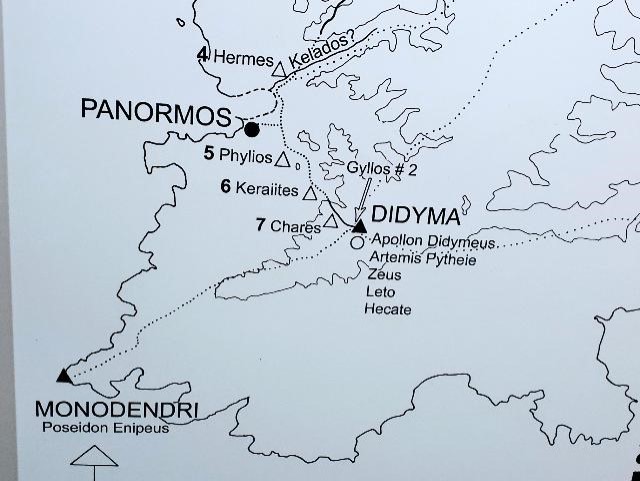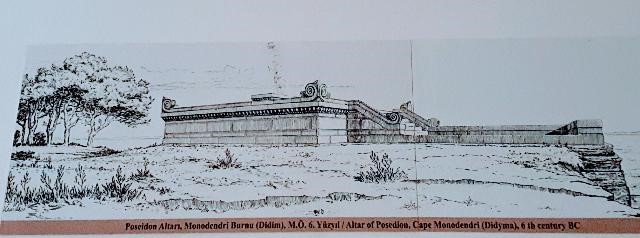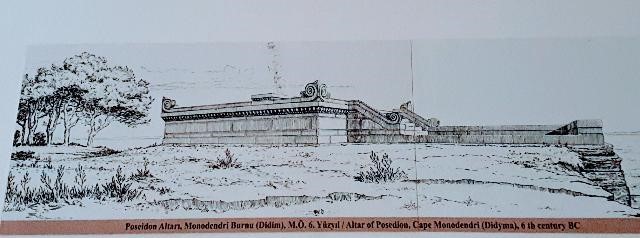The clement weather we appreciated in January (from the Roman god Janus, the two-faced god who looked both backward and forward; old year, new year) allowed myself and my equally historically inquisitive friend Jay Jean Jackson to venture out to Akköy. Our aim: to pick up the Sacred Road and then proceed in the direction of Didim.
By Glenn Maffia
It proved to be easy to locate and we managed to reach the summit of the hills, passing numerous sites of archaeological interest, whence the road suddenly plunged into thick undergrowth and the ravines of the downward slope.
We decided to retire to the Temple so to continue to wallow in the ancient world and enjoy a drink in the pleasant sunshine.
Pointing to the altar
It was while in conversation that Jay, a surveyor by profession, posed a question which both excited me in its logic and perplexed me in its probable significance, “I was looking at Google Earth and I noticed that the western side of the Temple looks like it could be aligned with the Altar of Poseidon. Could this be true or just rubbish?”

A possible location of the Altar of Poseidon
The altar is located next to the modern lighthouse looking out at the Aegean Sea, and extremely difficult to get to during the winter months along mud roads and brambles overhanging the narrow track.

The Altar of Poseidon
The processional road begins at the Delphinion of Apollo in central Miletus. Delphis is ancient Greek for Dolphin, an accoutrement of Apollo, and we have an altar to Poseidon (the god of the sea) in apparent alignment to the western wall of the Temple.
One may believe in coincidence, though it struck me as being so harmonious as to be embedded into the Greek aesthetics of their ancient art forms.
Posing questions
I contacted my archaeologist friends in Europe, some of whom have worked at the Temple of Apollo, none had any knowledge of any survey being conducted on any possible alignment between the two ancient sites.
I could not help but notice that the tone of their emails echoed the very same revelation of a harmonious thought in this an ancient design, if it can be proven.
One must also recognise that the Temple of Apollo has a rather strange orientation, and that questionable angle must possess a particular reasoning for its existence.
Both I and my close astronomer colleague, Alper Ateş, are certain the main eastern facade is aligned to a star in the Gemini constellation, named after a Roman mythological character, Castor, though the Greeks called this star Apollo. Thus, the orientation, designed by Greeks, of the Temple of Apollo was to align itself towards this star.
The question now is the dating of the Altar of Poseidon. I have read of a construction dating from the 6th BCE. This means that the altar predates the Hellenistic temple by as much as two centuries.
A digital model of this Greek altar has been constructed using data from the survey of the site by Armin von Gerkan.
The monumental altar has a maximum width of 11.09 metres and a length made up of two sections of 9.47 metres and 8.36 metres (total = 17.83 metres). Its point of orientation is not indicated in this research source.
As the degree of separation between the Archaic Temple (laid waste by the Persian forces after the Battle of Lade in 494 BCE) and the Hellenistic temple we see today is merely in the region of 1 degree, I don’t believe that would affect any alignment if indeed there is one.
Therefore the placement of the Temple could be designed to capture the star at its zenith while having its western wall pointing to the altar by the sea.
This could be a most exquisite feat of artistic planning. The received knowledge, so far, that no one has considered these alignments is a thrilling sensation for Jay and I alike.
Whether this theory stands the test of academic inquiry depends upon the evidence unearthed by the archaeologists, hopefully this summer season.
I am awaiting some consensus on the research of the altar from Europe and to ascertain if there have been any academic papers published on possible alignment.
As soon as I receive that information I can both inform you and expand upon the idea espoused by Jay Jean Jackson. Exciting days
